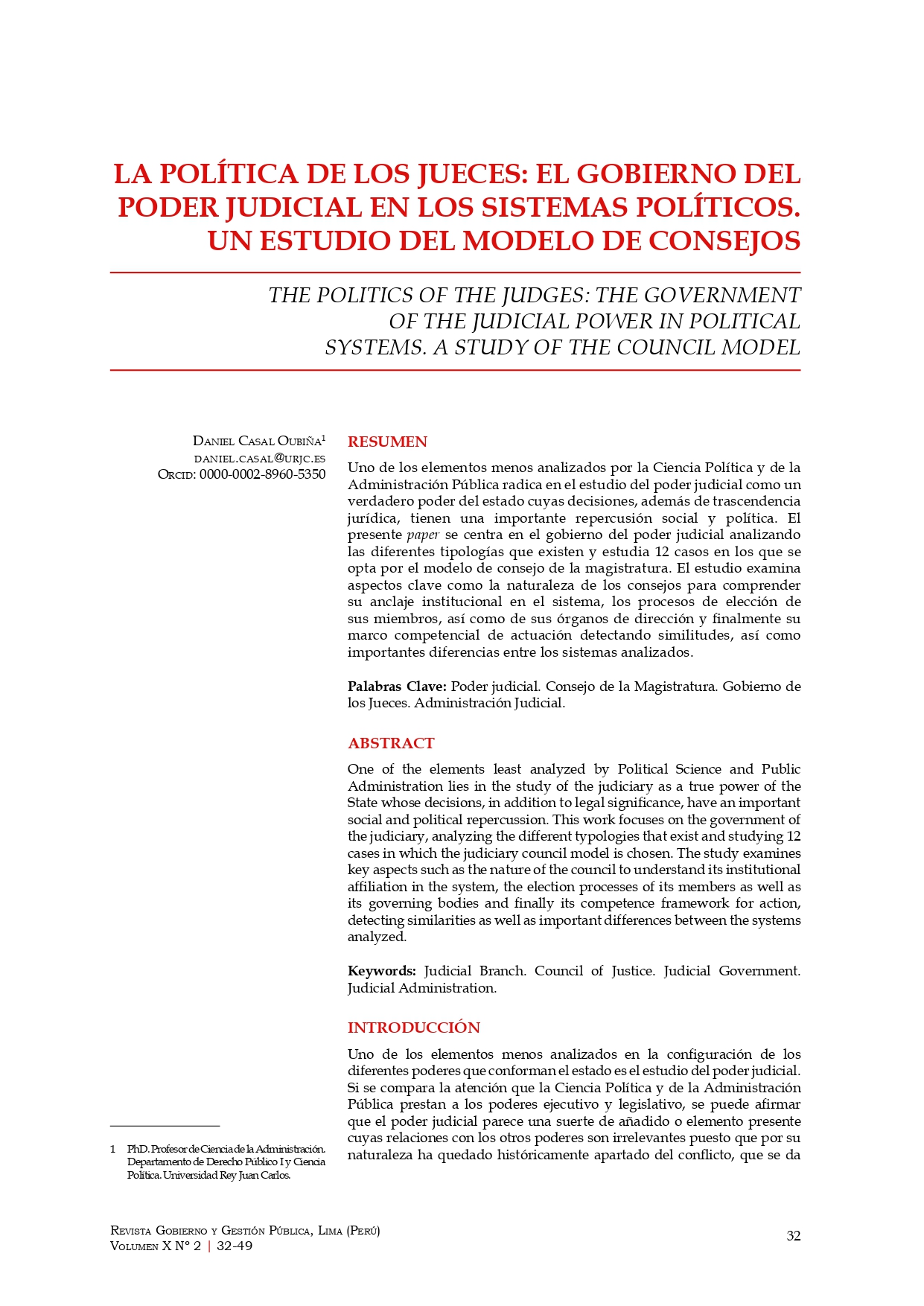THE POLITICS OF THE JUDGES: THE GOVERNMENT OF THE JUDICIAL POWER IN POLITICAL SYSTEMS. A STUDY OF THE COUNCIL MODEL
DOI:
https://doi.org/10.24265/iggp.2023.v10n2.04Keywords:
Judicial branch, Council of justice, Judicial Government, Judicial administrationAbstract
One of the elements least analyzed by Political Science and Public Administration lies in the study of the judiciary as a true power of the State whose decisions, in addition to legal significance, have an important social and political repercussion. This work focuses on the government of the judiciary, analyzing the different typologies that exist and studying 12 cases in which the judiciary council model is chosen. The study examines key aspects such as the nature of the council to understand its institutional affiliation in the system, the election processes of its members as well as its governing bodies and finally its competence framework for action, detecting similarities as well as important differences between the systems analyzed.
Downloads
References
Alcántara Sáez, M. (1995): Gobernabilidad y crisis. FCE México.
Alfonso, O. (1994): “Notas sobre el Consejo Superior de la Magistratura en Portugal”. Jueces para la Democracia 22: 97-101
Brace, P. Langer, L. (1995): “Studying Courts Comparatively: The View from the American States”. Political Research Quarterly 48: 5-29
Bin, R. y Pitruzzella, G. (2005): Diritto pubblico. Giappichelli Editore.
Currie, D. (1997): The Constitution in Congress. Chicago University Press.
Carcassone, G. y Guillaume, M. (2019): La Constitution. Points Essais.
Casal, D. (2022): “Integración Territorial y Parlamento. La posición de la Cámara Alta en Sistemas Políticos Descentralizados”. LEX Revista de la Facultad de Derecho y Ciencia Política de la Universidad Alas Peruanas 20(29): 43-76 https://doi.org/10.21503/lex.v20i29.2383
Daga, L. (1973): Il Consiglio Superiore della Magistratura. Jovene.
Delpeere, F. (1993): “El federalismo belga”. Anuario de Derecho Constitucional y Parlamentario 5: 91-102
Fitzpatrick, BT. (2009): “The Politics of Merit Selection”. Missouri Law Review 74(3): 675-706
Gangas, P. (2000): “El Sistema Político de Francia” en Alcántara Sáez, M. Sistemas Políticos de la Unión Europea. Tirant lo Blanc
Gleason, JA. (2016): State Judicial Selection Methods as Public Policy: The Missouri Plan. Purdue University Press.
González Aranda, P. (1993): Independencia del Juez y control de su actividad. Tirant lo Blanch.
Gulati, M. et al. (2007): “Profesionals or Politicians: The uncertain empirical case for an elected rather than appointed judiciary”. Journal of Law Economics and organization 26(2): 290-336
Hungtinton, S. (1991): La tercera ola. La democratización a finales del Siglo XX. Paidos.
Ibañez, P. y Movilla, C. (1986): El Poder Judicial. Tecnos.
Ibrahimnovic, EK. (2009): “El lugar de «los Otros» en la Constitución de Bosnia y Herzegovina. Larepresentación constitucional de las minorías y sus consecuencias sobre los derechos individuales”.Cuadernos Constitucionales de la Cátedra Fadrique Furia Ceriol 67-68: 135-152
Lijphart, A. (2016): Modelos de Democracia. Ariel.
Locke, J. (1660): Segundo Tratado sobre el Gobierno Civil. Tecnos.
López Guerra, LM. y Espín, E. (2022): Manual de Derecho Constitucional. Volumen II: La organización de los poderes Estado y Comunidades Autónomas. Tirant Lo Blanc.
López, E. (2015): “El Poder Judicial” en Sánchez Medero, G. y Sánchez Medero, R. (dirs.) Fundamentos de la Ciencia Política y de la Administración. Tecnos.
Martínez, R. (1998): El Semipresidencialismo: Estudio comparado. Universidad de Barcelona.
Mellado, P. y Sánchez, S. (2010): “El poder judicial y la justicia constitucional” en De Blas A. y Rubio Lara, MJ (dirs.) Teoría del Estado I. El Estado y sus instituciones. Editorial UNED.
Montesquieu, C. (1748): El Espíritu de las Leyes. Istmo.
Murillo de la Cueva, PL. (1995): “El gobierno del poder judicial: los modelos y el caso español”. Revista de las Cortes Generales 35: 167-239. https://doi.org/10.33426/rcg/1995/35/703
Nohlen, D. (2013): “El Presidencialismo Comparado”. Revista del Instituto de Altos Estudios Europeos,1: 6-23
Pérez Royo, J. (1997): Curso de Derecho Constitucional. Marcial Pons.
Pouille, A. (1985): Le Pouvoir Judiciare et les Tribunaux. Masson.
Reynoso, D. (2012): “Las variedades del bicameralismo en América Latina”. Miriada: Investigación en Ciencias Sociales 2(4): 9-50
Rivas Acuña, I. (2007): “Conceptos, teorías y modelos de la administración judicial en el Estado Constitucional”. Reforma Judicial, Revista Mexicana de Justicia 9: 95-132.
Ron Latas, RP. y Lousada, F. (2017): “Los Consejos de la Magistratura y otros modelos de gobierno judicial”. Anuario da Facultade de Dereito da Universidade de Coruña 21: 300-313
Verde, R. (2003): “El Poder Judicial en las Constituciones de Portugal y España”. Anuario de la Facultad de Derecho Universidad de A Coruña 21: 617-628.
Shugart, M. y Haggard, S. (2001): “Institutions and Public Policy in Presidential Systems”. S. Haggard y M. McCubbin: Presidents, Parliaments and Policy. University of California San Diego Press.
Verdú, PL. (1996): “Teoría General del Bicameralismo”. Tribuna de la Real Academia de CienciasMorales y Políticas 4:185-210

Downloads
Published
Issue
Section
License
Copyright (c) 2024 Daniel Casal Oubiña

This work is licensed under a Creative Commons Attribution-NonCommercial-ShareAlike 4.0 International License.














